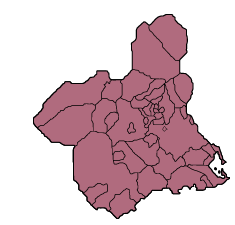British war memorial spray painted with Nazi symbols in Alicante
- Thu, 25.04.24 - 08:03


Welshman Captain Archibald Dickson rescued almost 3,000 people during the Spanish Civil War The memorial statue o...
Daytime temperatures will remain in the 20s throughout Alicante but widespread rain is forecast Weather outlook o...
Locals have launched a survey to establish which issues affect Orihuela Costa residents the most After almost s...
The victim has been identified as a Singapore tourist who was holidaying in Jávea, Alicante The Guardia Ci...
The suspected drug trafficker was collared as he checked into a hotel in Benidorm A British man suspected of bein...
The Arenales del Sol complex will take pride of place right in front of Elche beach Arenales del Sol in Elche is ...
England and Barca manager Terry Venables passed away recently, but do you know how else he is linked to Spain? Fo...
The magnitude 2.5 quake happened at about 5am this Wednesday morning The municipality of Jumilla in northern Murc...
Welshman Captain Archibald Dickson rescued almost 3,000 people during the Spanish Civil War The memorial statue o...
Get help with menopause anywhere in Europe with The Women's Health Clinic In a bid to extend their reach and ...
Daytime temperatures will remain in the 20s throughout Alicante but widespread rain is forecast Weather outlook o...
Both Nature and Man have left their mark on the rocks of Monte Arabí Over the course of the 10 million years ...
Works by the Yecla-born artist at the Casa Municipal de la Cultura in Yecla The evening of April 4 sees the opening o...
Both Nature and Man have left their mark on the rocks of Monte Arabí Over the course of the 10 million years ...
The popular Spanish singer performs at the Basílica of Caravaca One of the many special events being held this...
The Running of the Wine Horses takes place every year on May 2 The Running of the Wine Horses is one of the most exci...
Both Nature and Man have left their mark on the rocks of Monte Arabí Over the course of the 10 million years ...
Both Nature and Man have left their mark on the rocks of Monte Arabí Over the course of the 10 million years ...
Nurses, physiotherapists and other nursing home employees wanted in Spain Caser Residencial, the nursing home and...
Nurses, physiotherapists and other nursing home employees wanted in Spain Caser Residencial, the nursing home and...
Nurses, physiotherapists and other nursing home employees wanted in Spain Caser Residencial, the nursing home and...
Find out how you can donate blood in Spain and if you’re eligible Blood donation is a vital contribution to...
It’s a widely held belief in Spain that water canisters will prevent pets from marking their territory In r...
Find out everything you need to know to visit Spain’s unique festival of fireworks and fun The Valencia Fal...
Go along to the Rawhiders clubhouse in Callosa de Segura for good food and friendly company The Costa Blanca Rawh...
Carwash, airport transfers and more without any cancellation fees from Lowcostparking.es If you need to park your...
DGT Spain has confirmed that new drivers will have to pass a course to ride 125cc motorbikes Spain's General ...
DGT Spain has confirmed that new drivers will have to pass a course to ride 125cc motorbikes Spain's General ...
DGT Spain has confirmed that new drivers will have to pass a course to ride 125cc motorbikes Spain's General ...
The government is consulting with industry representatives to curb the worrying rise of tourist apartments The Mi...
Sometimes it’s tempting to hire the first, cheapest or nearest handyman you find, but there are good reasons to sh...
Both the donor and the beneficiary will have to pay some taxes in Spain Until recently, donating real estate to a...
Yes, you can do your Spanish tax declaration online… but it’s not the easiest way Taxpayers in Spain...
Both the donor and the beneficiary will have to pay some taxes in Spain Until recently, donating real estate to a...
Here’s what you need to know about avoiding the pitfalls of black money in property transactions in Spain I...
Prepare your property for any weather with Leak Proof all-in-one waterproofing and UV-resistant surface Did you k...
What really is the need to get a Pre-Purchase Technical Inspection for your Costa Blanca property? Purchasing a p...
Prepare your property for any weather with Leak Proof all-in-one waterproofing and UV-resistant surface Did you k...
The government is consulting with industry representatives to curb the worrying rise of tourist apartments The Mi...
Prepare your property for any weather with Leak Proof all-in-one waterproofing and UV-resistant surface Did you k...
The government is consulting with industry representatives to curb the worrying rise of tourist apartments The Mi...
Daytime temperatures will remain in the 20s throughout Alicante but widespread rain is forecast Weather outlook o...
The young woman dispensed the insect-laden coffee from a public machine in Palma de Mallorca Airport Next time yo...
The young woman dispensed the insect-laden coffee from a public machine in Palma de Mallorca Airport Next time yo...
Experts predict house prices in Spain will rise slightly amid fresh demand from foreign buyers As the summer seas...
The budget Irish airline has warned that more than half of the flights to and from Spain will experience delays on Thurs...
A Spanish court has decreed that LaLiga can fine viewers of pirate football, and not just the service providers LaLig...
Spain braces for springtime snowstorms, heavy rain and more chilly temperatures Weather outlook on Saturday April...
Welshman Captain Archibald Dickson rescued almost 3,000 people during the Spanish Civil War The memorial statue o...
